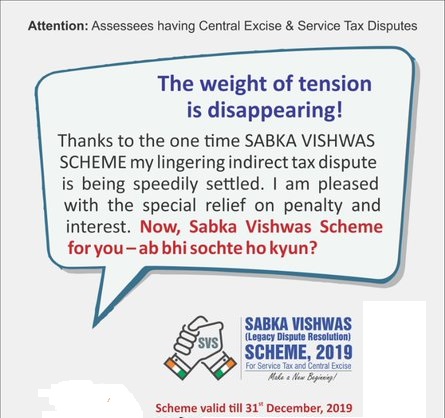Introduction:
Sabka Vishwas (Legacy Dispute Resolution) Scheme, 2019 was introduced by the Finance Act 2019 which has now come into force vide Notification No. 05/2019 Central Excise-NT dated 21st August, 2019. By this Notification, government made Sabka Vishwas (Legacy Dispute Resolution) Scheme Rules, 2019 which shall be effective from 1st day of September, 2019 onwards.
This scheme is introduced by the government to end the pre-GST era matters. This scheme offers benefit of 30%-70% of tax dues and waiver of 100% interest and penalty to the assessees covered under the scheme (hereinafter called as ‘declarant’).

Eligibility to claim benefit:
The scheme is allocable to SCN or Appeals pending as on 30.06.2019, audit, enquiry, investigation where quantification of tax dues are done on or before the 30th day of June, 2019 or where tax arrears are due but not paid.
Calculation of relief:
| Sr. No. | Tax dues on account of | Tax Benefit | |
| Tax Dues =< 50 lakhs | Tax Dues > 50 lakhs | ||
| 1 | SCN, appeals | 70% | 50% |
| SCN, appeals for late fee or penalty only | 100% | 100% | |
| 2 | Arrears | 60% | 40% |
| 3 | Enquiry, investigation or audit | 70% | 50% |
| 4 | voluntary disclosure | NIL | NIL |
Any deposit/ pre-deposit made by the declarant covered under the scheme shall be allowed to be adjusted for making payment of tax dues, however, no refund of deposit/ pre-deposit shall be granted. Also, payment cannot be done by utilizing ITC.
Ineligible Assessees:
1. SCN or Appeals which have been heard finally on or before the 30th day of June, 2019
2. Those who are convicted for any offence punishable under any provision of the indirect tax enactment
3. SCN related to refund /erroneous refund
4. Audit, enquiry, investigation, arrears where duty involved has not been quantified on or before the 30th day of June, 2019
5. Voluntary disclosure after being subjected to any enquiry or investigation or audit;
6. Voluntary disclosure after having filed a return under the indirect tax enactment, wherein he has indicated an amount of duty as payable, but has not paid it;
7. Who have filed an application in the Settlement Commission for settlement of a case;
8. Matter relate to excisable goods set forth in the Fourth Schedule to the Central Excise Act, 1944;
Procedure:
The entire procedure is required to be followed electronically.
1. The declarant needs to submit a declaration in Form SVLDRS-1 at https://cbic-gst.gov.in on or before the 31st December, 2019.
2. A designated committee shall verify the declaration on the basis of the particulars furnished by the declarant as well as the records available with the Department.
3. Designated committee shall, within a period of 60 days of receipt of declaration, issue a statement in Form SVLDRS-3 setting forth therein the particulars of the amount payable. No such statement shall be issued in a case the amount payable, as determined by the designated committee is nil and there is no appeal pending in a High Court or the Supreme Court.
4. If the payable amount estimated by the designated committee is more than the amount declared by the declarant, then, the designated committee shall, within a period of 30 days of the receipt of the declaration, issue in Form SVLDRS-2, an estimate of the amount payable by the declarant along with a notice of opportunity for personal hearing.
5. The declarant may indicate his agreement or disagreement with the estimate, may make written submissions or waive personal hearing or seek an adjournment by filing Form SVLDRS-2A, in absence of which the designated committee shall decide the matter based on available records.
6. On receipt of a request for an adjournment, the designated committee may grant the same in Form SVLDRS-2B.
7. Within 30 days of the date of issue of Form SVLDRS-3, the designated committee may modify its order to correct any arithmetical/ clerical error (apparent on the face of record or pointed out by the declarant or suo motu) by issuing a revised Form SVLDRS-3.
8. On receipt of order in Form SVLDRS-3, the declarant shall pay the amount of tax indicated in Form SVLDRS-3 within a period of thirty days from the date of its issue.
9. If any appeal, reference or writ is pending before High Court or Supreme Court, the declarant needs to submit a proof of withdrawal of such appeal, reference or writ.
10. On being satisfied that full payment is made by declarant and appeal, reference or writ is withdrawn, the designated committee shall issue discharge certificate in Form SVLDRS-4 within 30 days of the said payment and submission of the said proof, whichever is later.
11. On getting discharge certificate, the declarant shall not be liable to pay any further duty, interest, or penalty or prosecution with respect to the matter and time period covered in the declaration.






If assesse Appeal stands decided from commissioner appeal on 12 Th Th June but he has not filed appeal in Tribunal because there is 90 days time whether the assesse can avail this scheme .
Secondly if he had filed appeal in tribunal in August which is pending is he still eligible for the scheme .